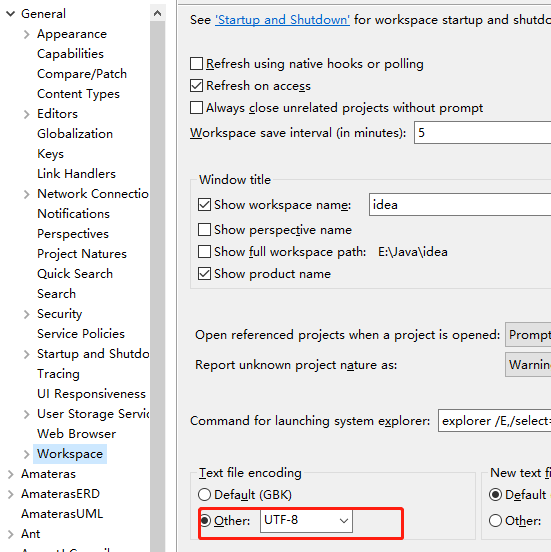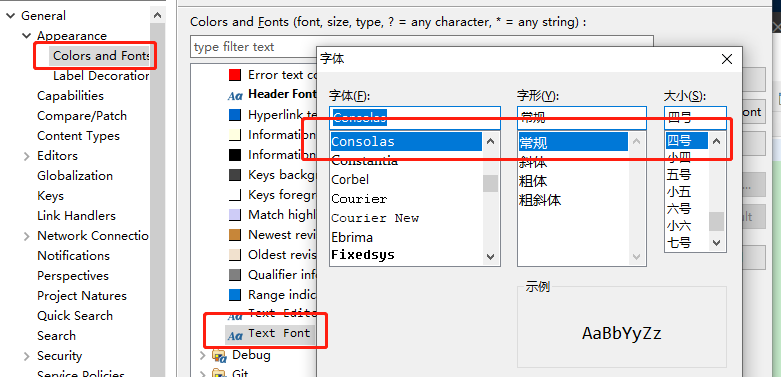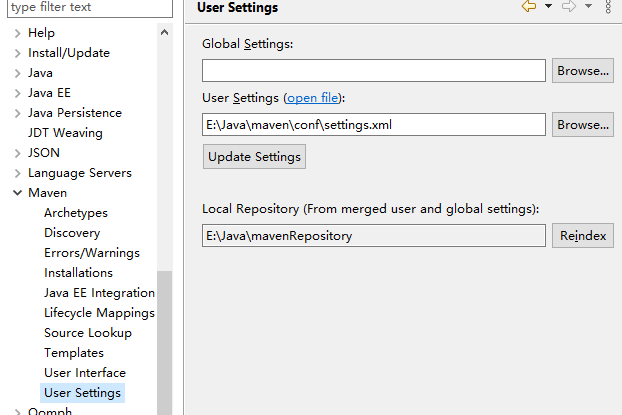Eclipse设置背景色等
1、设置背景色
a、Window->Preferences->General->Editors->Text Editors
b、选择Background color选择自定义颜色

2、设置编码格式General->Workspace

3、设置字体大小

4、设置maven

5、配置文件
maven


<?xml version="1.0" encoding="UTF-8"?> <!--
Licensed to the Apache Software Foundation (ASF) under one
or more contributor license agreements. See the NOTICE file
distributed with this work for additional information
regarding copyright ownership. The ASF licenses this file
to you under the Apache License, Version 2.0 (the
"License"); you may not use this file except in compliance
with the License. You may obtain a copy of the License at http://www.apache.org/licenses/LICENSE-2.0 Unless required by applicable law or agreed to in writing,
software distributed under the License is distributed on an
"AS IS" BASIS, WITHOUT WARRANTIES OR CONDITIONS OF ANY
KIND, either express or implied. See the License for the
specific language governing permissions and limitations
under the License.
--> <!--
| This is the configuration file for Maven. It can be specified at two levels:
|
| 1. User Level. This settings.xml file provides configuration for a single user,
| and is normally provided in ${user.home}/.m2/settings.xml.
|
| NOTE: This location can be overridden with the CLI option:
|
| -s /path/to/user/settings.xml
|
| 2. Global Level. This settings.xml file provides configuration for all Maven
| users on a machine (assuming they're all using the same Maven
| installation). It's normally provided in
| ${maven.conf}/settings.xml.
|
| NOTE: This location can be overridden with the CLI option:
|
| -gs /path/to/global/settings.xml
|
| The sections in this sample file are intended to give you a running start at
| getting the most out of your Maven installation. Where appropriate, the default
| values (values used when the setting is not specified) are provided.
|
|-->
<settings xmlns="http://maven.apache.org/SETTINGS/1.0.0"
xmlns:xsi="http://www.w3.org/2001/XMLSchema-instance"
xsi:schemaLocation="http://maven.apache.org/SETTINGS/1.0.0 http://maven.apache.org/xsd/settings-1.0.0.xsd">
<!-- localRepository
| The path to the local repository maven will use to store artifacts.
|
| Default: ${user.home}/.m2/repository
<localRepository>/path/to/local/repo</localRepository>
-->
<localRepository>E:\Java\mavenRepository</localRepository> <!-- interactiveMode
| This will determine whether maven prompts you when it needs input. If set to false,
| maven will use a sensible default value, perhaps based on some other setting, for
| the parameter in question.
|
| Default: true
<interactiveMode>true</interactiveMode>
--> <!-- offline
| Determines whether maven should attempt to connect to the network when executing a build.
| This will have an effect on artifact downloads, artifact deployment, and others.
|
| Default: false
<offline>false</offline>
--> <!-- pluginGroups
| This is a list of additional group identifiers that will be searched when resolving plugins by their prefix, i.e.
| when invoking a command line like "mvn prefix:goal". Maven will automatically add the group identifiers
| "org.apache.maven.plugins" and "org.codehaus.mojo" if these are not already contained in the list.
|-->
<pluginGroups>
<!-- pluginGroup
| Specifies a further group identifier to use for plugin lookup.
<pluginGroup>com.your.plugins</pluginGroup>
-->
</pluginGroups> <!-- proxies
| This is a list of proxies which can be used on this machine to connect to the network.
| Unless otherwise specified (by system property or command-line switch), the first proxy
| specification in this list marked as active will be used.
|-->
<proxies>
<!-- proxy
| Specification for one proxy, to be used in connecting to the network.
|
<proxy>
<id>optional</id>
<active>true</active>
<protocol>http</protocol>
<username>proxyuser</username>
<password>proxypass</password>
<host>proxy.host.net</host>
<port>80</port>
<nonProxyHosts>local.net|some.host.com</nonProxyHosts>
</proxy>
-->
</proxies> <!-- servers
| This is a list of authentication profiles, keyed by the server-id used within the system.
| Authentication profiles can be used whenever maven must make a connection to a remote server.
|-->
<servers>
<!-- server
| Specifies the authentication information to use when connecting to a particular server, identified by
| a unique name within the system (referred to by the 'id' attribute below).
|
| NOTE: You should either specify username/password OR privateKey/passphrase, since these pairings are
| used together.
|
<server>
<id>deploymentRepo</id>
<username>repouser</username>
<password>repopwd</password>
</server>
--> <!-- Another sample, using keys to authenticate.
<server>
<id>siteServer</id>
<privateKey>/path/to/private/key</privateKey>
<passphrase>optional; leave empty if not used.</passphrase>
</server>
-->
</servers> <!-- mirrors
| This is a list of mirrors to be used in downloading artifacts from remote repositories.
|
| It works like this: a POM may declare a repository to use in resolving certain artifacts.
| However, this repository may have problems with heavy traffic at times, so people have mirrored
| it to several places.
|
| That repository definition will have a unique id, so we can create a mirror reference for that
| repository, to be used as an alternate download site. The mirror site will be the preferred
| server for that repository.
|-->
<mirrors>
<!-- mirror
| Specifies a repository mirror site to use instead of a given repository. The repository that
| this mirror serves has an ID that matches the mirrorOf element of this mirror. IDs are used
| for inheritance and direct lookup purposes, and must be unique across the set of mirrors.
|
<mirror>
<id>mirrorId</id>
<mirrorOf>repositoryId</mirrorOf>
<name>Human Readable Name for this Mirror.</name>
<url>http://my.repository.com/repo/path</url>
</mirror>
-->
<mirror>
<id>nexus_aliyun</id>
<mirrorOf>central</mirrorOf>
<name>Nexus aliyun</name>
<url>http://maven.aliyun.com/nexus/content/groups/public</url>
</mirror> <mirror>
<id>aliyunmaven</id>
<mirrorOf>*</mirrorOf>
<name>阿里云公共仓库</name>
<url>https://maven.aliyun.com/repository/central</url>
</mirror>
<!--<mirror>
<id>alimaven</id>
<mirrorOf>central</mirrorOf>
<name>aliyun maven</name>
<url>http://maven.aliyun.com/nexus/content/groups/public</url>
</mirror>--> <mirror>
<id>Central</id>
<url>http://repo1.maven.org/maven2</url>
<mirrorOf>central</mirrorOf>
</mirror>
</mirrors> <!-- profiles
| This is a list of profiles which can be activated in a variety of ways, and which can modify
| the build process. Profiles provided in the settings.xml are intended to provide local machine-
| specific paths and repository locations which allow the build to work in the local environment.
|
| For example, if you have an integration testing plugin - like cactus - that needs to know where
| your Tomcat instance is installed, you can provide a variable here such that the variable is
| dereferenced during the build process to configure the cactus plugin.
|
| As noted above, profiles can be activated in a variety of ways. One way - the activeProfiles
| section of this document (settings.xml) - will be discussed later. Another way essentially
| relies on the detection of a system property, either matching a particular value for the property,
| or merely testing its existence. Profiles can also be activated by JDK version prefix, where a
| value of '1.4' might activate a profile when the build is executed on a JDK version of '1.4.2_07'.
| Finally, the list of active profiles can be specified directly from the command line.
|
| NOTE: For profiles defined in the settings.xml, you are restricted to specifying only artifact
| repositories, plugin repositories, and free-form properties to be used as configuration
| variables for plugins in the POM.
|
|-->
<profiles>
<!-- profile
| Specifies a set of introductions to the build process, to be activated using one or more of the
| mechanisms described above. For inheritance purposes, and to activate profiles via <activatedProfiles/>
| or the command line, profiles have to have an ID that is unique.
|
| An encouraged best practice for profile identification is to use a consistent naming convention
| for profiles, such as 'env-dev', 'env-test', 'env-production', 'user-jdcasey', 'user-brett', etc.
| This will make it more intuitive to understand what the set of introduced profiles is attempting
| to accomplish, particularly when you only have a list of profile id's for debug.
|
| This profile example uses the JDK version to trigger activation, and provides a JDK-specific repo.
<profile>
<id>jdk-1.4</id> <activation>
<jdk>1.4</jdk>
</activation> <repositories>
<repository>
<id>jdk14</id>
<name>Repository for JDK 1.4 builds</name>
<url>http://www.myhost.com/maven/jdk14</url>
<layout>default</layout>
<snapshotPolicy>always</snapshotPolicy>
</repository>
</repositories>
</profile>
--> <!--
| Here is another profile, activated by the system property 'target-env' with a value of 'dev',
| which provides a specific path to the Tomcat instance. To use this, your plugin configuration
| might hypothetically look like:
|
| ...
| <plugin>
| <groupId>org.myco.myplugins</groupId>
| <artifactId>myplugin</artifactId>
|
| <configuration>
| <tomcatLocation>${tomcatPath}</tomcatLocation>
| </configuration>
| </plugin>
| ...
|
| NOTE: If you just wanted to inject this configuration whenever someone set 'target-env' to
| anything, you could just leave off the <value/> inside the activation-property.
|
<profile>
<id>env-dev</id> <activation>
<property>
<name>target-env</name>
<value>dev</value>
</property>
</activation> <properties>
<tomcatPath>/path/to/tomcat/instance</tomcatPath>
</properties>
</profile>
-->
</profiles> <!-- activeProfiles
| List of profiles that are active for all builds.
|
<activeProfiles>
<activeProfile>alwaysActiveProfile</activeProfile>
<activeProfile>anotherAlwaysActiveProfile</activeProfile>
</activeProfiles>
-->
</settings>
Eclipse设置背景色等的更多相关文章
- 为Eclipse设置背景色
1:打开Eclipse,在菜单栏找到Help—>Install new software.. 2:在打开的Work with中输入: Update Site - http://eclipse-c ...
- Eclipse 设置背景色
window -> preferences -> General -> Editors -> Test Editors -> Background color 勾掉Sy ...
- Eclipse设置相同变量背景色高亮显示
在Eclipse中,鼠标选中或者光标移动到java类的变量名时,相同变量会被标识显示(设置背景色高亮), 并且侧边滚动条会标出变量的位置, 查找变量十分方便. 1.相同变量标识高亮显示: Window ...
- Eclipse 设置护眼背景色
Eclipse 设置护眼背景色 1.设置字体大小 Window --> Preferences --> General --> Apprearance --> Colors a ...
- [Java] Eclipse 设置相同变量背景色高亮显示
在Eclipse中,鼠标选中或者光标移动到java类的变量名时,相同变量会被标识显示(设置背景色高亮), 并且侧边滚动条会标出变量的位置, 查找变量十分方便. 1.相同变量标识高亮显示:Window ...
- 常用的Eclipse设置
每次新建work space的时候,我都要修改一些默认设置,每次都要花一些时间找在哪里设置,总结如下. 启动加速 1. 去掉XML Validataion Windows --> Prefere ...
- java中获取接口(方法)中的参数名字(eclipse设置编译参数)(java8 javac -parameters)
interface接口参数 jdk1.7及以前使用spring功能实现的: 注意: 1.该功能只能获取类的方法的参数名,不能获取接口的方法的参数名. public static void test() ...
- Eclipse设置、调优、使用(转自)
转自http://yuanzhifei89.iteye.com/blog/974082 eclipse调优 一般在不对eclipse进行相关设置的时候,使用eclipse总是会觉得启动好慢,用起来好卡 ...
- Eclipse设置不格式化注释
Eclipse设置不格式化注释 注释中写点带格式的文字,format后全乱了,解决办法如下: Windows -> Preferces -> java -> Code Style - ...
- 安装Maven、Eclipse设置、添加地址JAR
1.下载Maven 地址:http://maven.apache.org/download.cgi 2.安装Maven 系统变量:MAVEN_HOME = D:\maven\apache-maven- ...
随机推荐
- ajax的原理是什么?如何实现?
一.是什么 AJAX全称(Async Javascript and XML) 即异步的JavaScript 和XML,是一种创建交互式网页应用的网页开发技术,可以在不重新加载整个网页的情况下,与服务器 ...
- 如何快速把导出的csv表格数据导入到SqlServer中
(不要建自增字段,否则会出现第一个字段数据进不去的情况) 1.打开csv表格 2.打开要导入的表,右键编辑前两百行 3.表格中CTRL+C 数据库中CTRL+V 搞定! ** ...
- Linux新手渣渣上路史
Linux新手渣渣上路史 时至2022年,IT行业的迅速发展大家也有目共睹,IT行业在社会的发展中起着举足轻重的作用.其中一角Linux系统,从诞生到开源,再到现在受大众的欢迎,是一个很好的例子.Li ...
- LOJ3075 「2019 集训队互测 Day 3」组合数求和
题意: 令 \(f(j)=\sum\limits_{i=0}^{n-1}\dbinom{id}{j}\) ,对于 \(0\le j <m\) ,分别求出 \(f(j)\) .答案对 \(M\) ...
- windows注册表的读
1.打开 2.读取 //打开注册表 CString CDownDlg::GetPortCom(int nmber)//读取操作表,其类型为REG_SZ { CString ans; CString r ...
- 【C学习笔记】day4-2 求出0~999之间的所有“水仙花数”并输出。
2.求出0-999之间的所有"水仙花数"并输出."水仙花数"是指一个三位数,其各位数字的立方和确好等于该数本身,如:153=1+5+3?,则153是一个&quo ...
- gitlab中CI/CD过程中的坑
先上观点,azure的pipeline比gitlab ce版好用,gitlab收费版没有用过. 在.gitlab-ci.yml中的特殊字符处理: 解决方法: cmd="[$var1] &am ...
- VUE学习-mixin混入
mixin混入 混入 (mixin) 提供了一种非常灵活的方式,来分发 Vue 组件中的可复用功能. 组件式混入 // 定义一个混入对象 var myMixin = { created: functi ...
- 七、25.创建user子分支并把代码推送到码云仓库中
打开终端点击+新建一个终端 注意 :如下操作都是在2:powershell下进行 先来检查一下当前所处分支 git branch 我们应该把这些代码都写到user分支上 接下来应该把这些代码统一迁移到 ...
- docker 安装 服务
服务所需 mysql,redis,nfs,rsync,nginx,以及自己的后端服务 mysql docker run --restart=always -d -v /etc/localtime:/e ...
